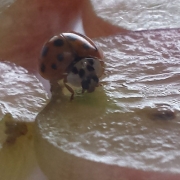Our ladybugs usually hibernate inside the crevices of the split trunk of a wild cherry tree. In late spring, after leaves have sprouted and temperatures are consistenly near 60 degrees, they emerge from hibernation. When they emerge, they do so all at once. There will be a spontaneous eruption of thousands of ladybugs crawling in the grasses surrounding the tree. They move a little sluggishly and don’t immediately start flying. It seems to take until mid-day before they stretch their wings. But by late afternoon, they’ve scattered throughout the property and can be found exploring the brush and shrubs for aphids. From there, they spend the rest of the season helping us naturally control the pests that plague our roses, clematis and other plants.

Ladybugs In The House In Winter
It’s not uncommon for us to find one or two ladybugs inside the house during the winter. We usually find them crawling near a door or window, probably close to the opening that they crawled into to hibernate. The warmth inside the house possibly drew them in. Since they don’t do any damage to the house, we really wouldn’t mind a few flying around inside. After all, they’re said to bring good luck. But it wouldn’t be good luck for the ladybug because there’s no food source for them to find inside and the dry, arid air and low humidity inside would quickly cause them to die of dehydration.
Saving The Ladybugs
Hibernating ladybugs use the fat reserves inside their bodies to get them through the winter. The cracks and crevices they normally hibernate inside hold enough moisture or humidity to prevent dehydration. A ladybug in the house in winter will be running low on fat reserves. There won’t be any insects or nectar for it to replenish fat reserves, and it will quickly dehydrate and die.
To help the ladybugs make it through to spring, we get them rehydrated and then ease them back into hibernation. We’ve done this for several years now and have some tips to share if you find yourself in the same situation.
- Line a quart-sized mason jar or large plastic container with moist leaf litter. Add a few sticks or tree bark for climbing.
- Cut several grapes in half and lay them on top of the leaf litter inside the bottom of the jar. We use grapes because they have a high moisture and sugar content. They safely provide both fat and water for the ladybug. People have used small water dishes to provide moisture, but that will only drown the ladybug. They can get all the water they need from the grapes, with the added bonus of sugar to build up their fat reserves.
- Place the ladybug inside the jar and cover the top with a thin cloth and secure to the jar with a rubber band.
- Replace the old grapes with fresh grape halves on the bottom of the jar each day.
- After 3-4 days, get the ladybug ready for hiberation by reducing the amount of light and exposing it to temperatures around 40 degrees. We do this by placing the jar in the garage or attic for a day. The next day, place the jar outside for an hour or so to expose the ladybug to the cold temps. After an hour has passed, the ladybug will be fairly sluggish. Place the ladybug on the underside of a large piece of bark or a section of wooden plank. Something about 6 inches in width and 8 inches in length. Lean the bark or wooden plank up against the base of a tree and cover any open areas loosely with leaf litter. The ladybug is now ready to finish hibernating and will emerge on its own when ready.

Ladybug Facts
Ladybugs can live 1-3 years
They primarily eat insects, but will also eat pollen and nector to bulk up their fat reserves before hibernation
They need temperatures above 55 degrees in order to fly and forage for insects
They use the fat reserves in their bodies for nutrition during hibernation
Ladybugs emerge from hibernation when temperatures are consistently above 59 degrees
